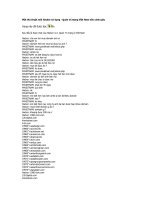Quản trị mạng CCNP.Sem3
Bạn đang xem bản rút gọn của tài liệu. Xem và tải ngay bản đầy đủ của tài liệu tại đây (34.46 KB, 4 trang )
Nguyen Khac Quyet - Take Exam
Exam questions
Time remaining: 00: 40: 02
1 . IEEE 802.1w RSTP defines which of the following port states ?
Listening, Learning, Forwarding, Blocking, Disabled
Learning, Forwarding, Discarding
Learning, Active, Block
Listening, Forwarding, Active, Blocking
2 . Broadcast storms can:
Disrupt the network by absorbing all bandwidth capacity
Sometimes be useful depending on the circumstance
Not interfere with your bandwidth
Be an indication that you need more bandwidth
3 . The root bridge will have a priority of ______ and a secondary priority of ______ when using the “set spantree root” command.
8192, 16384
512, 1024
1024, 2048
16384, 32768
4 . Once STP has completed running its algorithm, which of the following states could a port be in? Choose all the correct answers.
Blocking
Listening
Forwarding
Disabled
5 . If you have a port speed set for auto-negotiation:
you must set the duplexing manually
you won’t be able to manually set the duplexing
the port will not dynamically configure itself with a speed that is supported by the connecting device
the port only supports one speed
6 . From the following “show spantree vlan-number” output, how can you tell if you’re looking at the data from the root bridge? Choose
two. show spantree 2 VLAN 2 Spanning tree enabled Designated Root 00-50-74-7f-4a-00 Designated Root Priority 32768 Designated
Root Cost 0 Designated Root Port 1/0 Root Max Age 20 sec Hello Time 2 sec Forward Delay 15 sec Bridge ID MAC ADDR 00-50-74-
7f-4a-00 Bridge ID Priority 32768 Rest of output omitted
The Bridge ID Priority and the Designated Root Priority are the same
The Designated Root and the Bridge ID MAC ADDR are the same
The Root Max Age is more than 15 seconds
The Designated Root Cost is zero (0)
7 . The spanning tree protocol decides which port to disable based on three things. What are they?
Port cost
Port priority
Port distance
MAC address
8 . "How does a non-Root switch choose its Root Port?
It chooses the port with the lowest cumulative Root Path Cost to the Root Bridge.
It chooses the port with the highest cumulative Root Path Cost to the Root Bridge.
The port receives an inferior BPDU from a neighboring switch on a shared LAN segment.
The port receives a BPDU announcing a higher Root Path Cost from a neighboring switch on a shared LAN segment.
9 . As your network grows, it is important to:
Add as many routers as possible, which will give redundancy
Make sure that the root bridge selected will be the most optimal for your network
Limit the number of designated roots in the network
Set up eight-port EtherChannels, if possible
10 . The designated bridge on each LAN segment is elected using:
the switch within the segment with the lowest accumulated path cost to the root bridge
the switch within the segment with the highest accumulated path cost to the root bridge
the switch within the segment with the lowest bridge identifier or lowest MAC address
the switch within the segment with the highest bridge identifier
11 . On a Catalyst switch, what happens when a port is attached or removed and the spanning tree is turned on?
The ports go into listening mode for 10 seconds
The ports go into learning mode for 15 seconds
The ports go into blocking mode for 15 seconds
The ports go into sleeping mode for 20 seconds
12 . Fast EtherChannels:
use two line modules that act as a single module
is configured as separate instances of spanning tree per link
treats two links as a single spanning tree logical link
use gigabit Ethernet
13 . Spanning Tree Algorithm is used in bridged or switched LANs to:
Identify destinations for multicasts
Flood segments with frames from unknown sources
Identify the segments connected to the bridge or switch
Flood segments with frames to unknown destinations
Avoid broadcast storms by eliminating loops in the network
14 . Loops within one spanning tree can:
cause problems with other spanning trees
do not effect other spanning trees
Distribute root bridge information
Distribute designated bridge information
15 . Spanning Tree Protocol guarantees a loop-free environment and an optimal configuration.
True
False
16 . How would you reduce BPDU traffic when there is only one root bridge?
Increase the Hello Time timer
Decrease the Max Age timer
Add an additional root bridge
Set the port channel
17 . The root bridge is elected using:
the lowest accumulated path cost to the root port
the highest accumulated path cost to the root port
the lowest bridge identifier or lowest MAC address
the highest bridge identifier
18 . If a bridge receives BPDUs from multiple ports, what does this tell you?
That there is a preferred path and also a redundant path to the root port
That there are multiple paths to the root bridge and one of them will have to be disabled
That there are multiple paths to the root bridge and both of them will have to be disabled
That there are multiple paths to the root bridge and both of them should be enabled
19 . The root ports on each switch are elected using:
the port on each switch with the lowest accumulated path cost to the root bridge
the port on each switch with the highest accumulated path cost to the root bridge
the port on each switch with the lowest bridge identifier or lowest MAC address
the port on each switch with the highest bridge identifier
20 . It is highly recommended that UplinkFast only be configured on:
Distribution switches
Leaf switches
Core Switches
Both Access and Distribution switches
Showing page 1 of 1 :
Submit
Go!
© 2004 HanoiCTT. All rights reserved.









